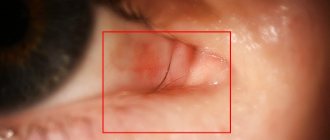When prescribing an antibiotic to treat a bacterial infection, the doctor usually indicates its generally accepted designation in the prescription. This so-called INN (international nonproprietary name) is not tied to a specific manufacturer, of which there are now many. In the pharmacy, the same antibiotic is often available under different brand names from imported or domestic companies, as is the case with ciprofloxacin and Tsiprolet. Ultimately, either the pharmacist or the consumer himself will have to decide what is best to choose. Let's look at their differences.
There are contraindications, use after consulting your doctor
Tsiprolet and Tobrex - what is the difference
Tsiprolet or Tobrex are used to treat purulent inflammatory eye diseases.
They have a wide spectrum of antibacterial action.
These drugs are best used when eye disease is caused by bacteria that are resistant to drug therapy.
Tsiprolet
The active ingredient in these drops is ciprofloxacin hydrochloride. In ophthalmology it is used for:
This drug is also prescribed for the prevention of purulent-inflammatory complications in the post-traumatic or postoperative period.
Tsiprolet is prohibited from use in case of individual intolerance to the main medicinal substance. Not for use in children, pregnant or lactating women.
Adults receive 1 – 2 drops of Tsiprolet into the conjunctival sac. The frequency of instillation is every 4 hours. In particularly severe cases, instillation is carried out every hour until the patient’s condition stabilizes.
When using eye drops, an overdose is impossible. Side effects such as nausea, vomiting, taste disturbances, and low blood pressure are rare. Drops are stored in dark and dry places for no more than 3 years.
Tobrex
These are drops with the active ingredient tobramycin. The substance has a wide spectrum of action and belongs to the group of aminoglycosides. Effective against a large number of microorganisms that cause purulent diseases.
Used to treat:
- streptococcal and staphylococcal eye infections - blepharitis, keratitis and keratoconjunctivitis;
- blepharoconjunctivitis;
- infectious lesions after surgical treatment of the organ of vision.
Tobrex cannot be prescribed if the patient suffers from hypersensitivity to the active substance. Prescribed with caution during pregnancy and breastfeeding. Typically, a doctor will prescribe a medicine only in cases where the benefits of its use are greater than the potential risks. When using Tobrex during lactation, breastfeeding is temporarily stopped.
1 or 2 drops of medication are injected into the conjunctiva. The frequency of administration depends on the degree of infection of the eye. During the acute period of the disease and in severe cases, drops are administered hourly until the patient’s condition stabilizes.
An overdose of Tobrex is impossible. Side effects - nausea or dizziness, photophobia, allergic reactions in the form of redness of the eyelids are extremely rare. The shelf life of the drug is 3 years.
Comparison of drugs
Both drugs contain antibacterial substances. They are effective in the treatment of eye diseases caused by exposure to microorganisms, and significantly alleviate the patient’s condition within a few days from the start of use.
Tobrex and Tsiprolet have a similar method of application. Both medications also do not cause overdose and extremely rarely have side effects.
The difference between drugs is that they contain different active ingredients. Due to the nature of the action of ciprofloxacin, it is not prescribed during pregnancy. Tobrex can be used by pregnant women if the symptoms of conjunctivitis are associated with a serious deterioration in health.
What's better
Analysis of the pharmacological action of the drugs in question gives grounds to assert that both drugs effectively fight the causative agents of bacterial conjunctivitis. Tobrex is best used for acute and severe conditions, when it is necessary to quickly normalize the patient's condition.
Simultaneous use of Tsiprolet and Tobrex
The simultaneous use of these drugs is not allowed, because they contain different pharmacologically active components. Ignoring this rule leads to a deterioration in the patient’s condition and a decrease in the effectiveness of treatment.
Tobrex and Tsiprolet are effective means for getting rid of the manifestations of bacterial conjunctivitis. Recommended for acute forms of pathologies. Patients usually experience significant improvement in their health within a few days.
Poor vision significantly worsens the quality of life and makes it impossible to see the world as it is.
Not to mention the progression of pathologies and complete blindness.
MNTK "Eye Microsurgery" published an article on non-surgical restoration of vision up to 90%, this became possible thanks to...
Read more Was this article helpful?
Rate the material on a five-point scale!
( 1 1.00
Source: https://proglazki.ru/kapli-dlya-glaz/tsiprolet-i-tobreks/
Comparison of the effectiveness of Tsiprolet and Signitsef
The effectiveness of Tsiprolet is quite similar to Signicef - this means that the ability of the drug substance to provide the maximum possible effect is similar.
For example, if the therapeutic effect of Tsiprolet is more pronounced, then using Signicef even in large doses will not achieve this effect.
Also, the speed of therapy - an indicator of the speed of therapeutic action - is approximately the same for Tsiprolet and Signitsef. And bioavailability, that is, the amount of a drug reaching its site of action in the body, is similar. The higher the bioavailability, the less it will be lost during absorption and use by the body.
Which medicine is better and more effective: Tsiprolet or Tsipromed
For bacterial infections, antimicrobial agents . This group of drugs includes Tsiprolet and Tsipromed. These drugs are analogues. But they have not only similarities, but also differences that need to be known before starting therapy.
Tsipromed
Tsipromed contains ciprofloxacin as its main component.
The drug is available in two dosage forms:
- Eye drops , which are used to treat infectious and inflammatory diseases of the eye and its appendages. They are prescribed for conjunctivitis, keratitis, anterior uveitis, blepharitis and other eyelid infections, dacryocystitis. They can be used for the treatment and prevention of infectious complications after eye injury or surgery.
- Ear drops , which are used to treat infectious diseases of the ears, such as external, middle and internal otitis, eustachitis. They are recommended for the prevention of otitis during surgery and ear injuries, or removal of a foreign object from the ear canal.
General characteristics
Both drugs contain ciprofloxacin as an active ingredient, to which the following microorganisms are sensitive:
- Escherichia coli.
- Salmonella.
- Shigella.
- Citrobacter.
- Klebsiella.
- Enterobacteriaceae.
- Proteas.
- Morganella morgani.
- Serrations.
- Hafnia.
- Edwardsiella tarda.
- Providence.
- Vibrios.
- Yersinia.
- Haemophilus influenzae and Pseudomonas aeruginosa.
- Moraxella.
- Aeromonas.
- Neisseria.
- Pasteurella.
- Plesiomonas.
- Campylobacter jeuni.
- Legionella.
- Brucella.
- Listeria monocytogenes.
- Mycobacteria, including tuberculosis.
- Staphylococci.
- Streptococci.
- Corynebacterium diphtheria.
In addition, there are the following similarities between the drugs Tsiprolet and Tsipromed:
- Both drugs are manufactured in India .
- Both drugs can be purchased with a doctor's prescription .
- Both medications should not be prescribed to pregnant women or those who are breastfeeding.
- During treatment with these drugs, you must be careful when driving a car and when working in potentially hazardous work.
- Both drugs can cause allergies .
- Tsiprolet and Tsipromed eye drops can cause burning, itching, pain, redness of the eye mucosa, swelling of the eyelids, photophobia, lacrimation, sensation of a foreign object in the eyes, unpleasant taste in the mouth immediately after instillation, blurred vision, keratitis, keratopathy, spots. or infiltration of the cornea, superinfection. In patients with corneal ulcers, a white crystalline precipitate may appear.
Differences
Tsiprolet and Tsipromed have the following differences:
| Tsiprolet | Tsipromed | |
| Release form | The drug is commercially available in eye drops, solution for infusion, and tablets for oral administration. | The drug is available in the form of ear and eye drops. |
| Use in pediatrics | Eye drops can be used for patients older than 12 months. Tablets and infusions can be prescribed to children over 5 years of age to treat and prevent pulmonary anthrax. They can also be prescribed to patients in this age group suffering from cystic fibrosis to prevent complications caused by Pseudomonas aeruginosa. | Eye drops are allowed for children over 1 year of age, ear drops are allowed only for patients over 15 years of age. |
| Adverse reactions | Tablets and infusions can cause dizziness, cephalgia, fatigue, insomnia, trembling of certain parts of the body, anxiety, nightmares, peripheral paraalgesia, excessive sweating, intracranial hypertension, depression, hallucinations, migraines, fainting, thrombosis of the cerebral arteries, agitation , disorientation, convulsions, paresthesia, dysesthesia, hypoesthesia, gait disorder, hyperesthesia, peripheral neuropathy and polyneuropathy, perversion of taste and smell, double vision, hearing loss, tinnitus, increased heart rate, prolongation of the QT interval, vasodilatation, hypotension, ventricular arrhythmias, nausea, vomiting, indigestion, abdominal pain, bloating, lack of appetite, inflammation of the pancreas, hepatitis, hepatonecrosis, inhibition of bone marrow hematopoiesis, serum sickness, a decrease in the amount of all formed blood elements, the appearance of blood and protein in the urine, crystalluria, dysuria , polyuria, urinary retention, renal failure, glomerulonephritis, bleeding from the urethra, interstitial nephritis, respiratory failure, joint and muscle pain, arthritis, tendovaginitis, tendon rupture, impotence, muscle hypertonicity, muscle weakness, exacerbation of myasthenia gravis, increased activity of liver enzymes, levels creatinine, bilirubin and sugar, hot flashes, superinfection. Infusions can cause swelling at the injection site. | Ear drops can cause the eardrum to become red and painful. |
What to choose?
Despite the fact that the drugs are complete analogues, they have different release forms and areas of application.
For eye infections, you can use any of these eye drops. For ear diseases, you need to use Tsipromed in the form of ear drops, and for infections of internal organs - Tsiprolet in tablets or infusion solution.
Source: https://vchemraznica.ru/kakoj-medicament-luchshe-i-effektivnee-ciprolet-ili-cipromed/
Characteristics of Tsiprolet
Tsiprolet is produced in three dosage forms: in the form of eye drops, a solution for infusion and in tablet form.
The active component of the drug is ciprofloxacin. In addition to this component, the tablets contain a second active ingredient - tinidazole.
Additional components of the medication in the form of an injection solution and eye drops are the following compounds:
- water for injection;
- disodium edetate;
- hydrochloric acid;
- benzalkonium chloride in the form of a solution;
- sodium chloride.
Tsiprolet tablets contain the following compounds as additional components:
- croscarmellose sodium;
- corn starch;
- sodium carboxymethyl starch (type A);
- MCC;
- colloidal silicon dioxide;
- talc;
- magnesium stearate;
- hypromellose;
- titanium dioxide;
- macrogol 6000;
- dimethicone;
- polysorbate 80;
- sunset yellow dye (E110).
The drug in any form of release has pronounced antiprotozoal and antimicrobial properties.
The mechanism of action of the main active component is manifested in the suppression of DNA gyrase of the bacterial cell, which provokes disturbances in the process of bacterial DNA synthesis, and this leads to a slowdown in the growth and reproduction of the bacterial pathogen. This effect on the bacterial cell provokes its death.
Tsiprolet tablets are used for drug therapy of diseases and pathological conditions such as:
- Bacterial lesions of the respiratory system: cystic fibrosis, bronchitis, bronchiectasis, pneumonia and tonsillitis.
- Lesions of a bacterial nature in the ENT organs: tonsillitis, pharyngitis, otitis media, mastoiditis, sinusitis and sinusitis.
- Infection of the genitourinary system: salpingitis, cystitis, pyelonephritis, oophoritis, tubular abscess, adnexitis, prostatitis, gonorrhea, chlamydia, chancre, pelvioperitonitis and pyelitis.
- Pathologies of the digestive system: peritonitis, typhoid fever, salmonellosis, intraperitoneal abscesses, yersiniosis, campylobacteriosis, cholera, shigellosis,
- Bacterial lesions of the skin: phlegmon, abscess, burns, infected ulcers, wounds.
- Pathologies of the osteoarticular system caused by bacterial infection: sepsis, septic arthritis and osteomyelitis.
Tsiprolet is used for infections of the genitourinary system.
Tablet and injection forms of the drug can be used for prophylactic purposes to prevent bacterial infection after surgical interventions.
Tsiprolet eye drops are prescribed for drug treatment of conjunctivitis, blepharitis, and barley.
When prescribing the drug, the patient should take into account the following contraindications:
- minority;
- intolerance to the components of the drug;
- pregnancy period;
- lactation period.
The medication should be prescribed with caution when:
- impaired blood circulation in brain tissue;
- atherosclerosis of cerebral vessels;
- presence of epileptic syndrome;
- epilepsy;
- mental disorders;
- severe pathology of the liver and kidneys;
- old age.
During treatment, the patient may experience a whole range of side effects and unwanted reactions.
From the digestive system:
- vomit;
- diarrhea;
- flatulence;
- epigastric pain;
- feeling of nausea;
- bloating;
- cholestatic jaundice;
- decreased appetite;
- hepatonecrosis;
- hepatitis.
On the part of the nervous system, the patient may develop:
- insomnia;
- dizziness;
- anxiety;
- fatigue;
- tremors of the limbs;
- increased intracranial pressure;
- increased sweating;
- hallucinations;
- depression;
- confusion;
- different mental reactions;
- thrombosis of cerebral arteries;
- fainting;
- migraine.
Sense organs may react to the use of Tsiprolet with the following undesirable reactions:
- decreased hearing acuity;
- tinnitus;
- violation of taste perception;
- diplopia.
The patient may develop:
- tachycardia;
- drop in blood pressure;
- heart rhythm disturbances;
- anemia;
- granulocytopenia;
- leukocytosis.
Carrying out drug treatment with Tsiprolet can provoke the occurrence of allergic reactions in the form of urticaria, arthralgia, tenosynovitis and arthritis.
If an overdose occurs, increased side effects are observed. To eliminate the pathological condition, gastric lavage and hemodialysis are used.
The drug is dispensed at the pharmacy only after presenting a prescription from the attending physician.
Ciprofloxacin or Ciprolet: which is better and what is the difference (differences in composition, reviews from doctors)
Ciprofloxacin belongs to the group of fluoroquinolones. The substance is one of the most effective antibacterial agents. Often used in clinical practice, it is produced by manufacturers under different trade names. The drugs Ciprofloxacin and Tsiprolet are drugs in which this substance acts as an active component.
Characteristics of Ciprofloxacin
The drug has an antibacterial effect and has the ability to cause the death of pathogenic microorganisms. Produced by a number of Russian manufacturers. Israeli-made tablets are also available on the pharmaceutical market.
Ciprofloxacin has an antibacterial effect and has the ability to cause the death of pathogenic microorganisms.
The following forms of the drug are available:
- tablets (250 and 500 mg);
- solution for infusion (200 mg per 100 ml);
- drops for eyes and ears (3 mg);
- ointment (0.3 g per 100 g).
The active ingredient is ciprofloxacin. It has an inhibitory effect on bacterial DNA gyrase, disrupting the DNA synchronization mechanism and the formation of cellular proteins in microorganisms.
The activity of the drug is manifested against bacteria that are in the stage of rest and reproduction.
Characteristics of Tsiprolet
The medicine is produced by the Indian manufacturer Dr. Reddy's Laboratories Ltd. Implemented in the following forms:
- tablets of 250 and 500 mg;
- solution for intravenous administration (2 mg per 1 ml);
- eye drops (3 mg).
The main substance in the composition is ciprofloxacin. The pharmacological effect completely coincides with the mechanism of action of the previous drug.
Comparison of Ciprofloxacin and Ciprolet
Both drugs are fluoroquinolone antibiotics.
Similarities
When comparing drugs, the main properties do not differ:
- They contain the same active ingredient.
- The drugs have the same dosage form and dosage options. The treatment regimen and course duration depend on the disease and are calculated individually by the attending physician, taking into account the patient’s clinical picture and medical history.
- Mechanism of action. In bacteria, the enzyme gyrase (belongs to the group of topoisomerases) is responsible for the construction of supercoils in the circular DNA molecule. The active ingredient blocks the activity of the enzyme. This leads to stopping the growth of bacteria and their death, stopping the infectious process.
- In both cases, the active component is effective against a number of enterobacteria, cellular pathogens, and affects gram-negative and gram-positive environments. The bacteria Ureaplasma urealyticum, Clostridium difficile, and Nocardia asteroides are resistant to the substance. Treponema pallidum and mushrooms are not sensitive to drugs.
- Indications for use. Both drugs are prescribed in the treatment of infectious diseases in uncomplicated forms and cases of secondary infection joining a bacterial infection. Indications include infections of the respiratory tract and ENT organs. Medicines are widely used for lesions of the eyeball, diseases of the kidneys and genitourinary system, and pelvic organs. The list of prescriptions includes infections of the digestive system, biliary system, skin, bone and soft tissue. The drugs are used for sepsis and peritonitis.
- Medicines have the same list of contraindications for use: pregnancy and breastfeeding, age less than 18 years, individual intolerance. Careful use requires a history of impaired blood circulation and cerebral atherosclerosis, mental disorders, and epilepsy. Treatment requires special monitoring in elderly patients, as well as in the presence of diabetes mellitus and severe liver and kidney failure.
- Possible side effects from the cardiovascular and nervous systems, gastrointestinal tract and liver, musculoskeletal system, and hematopoietic system do not differ. External manifestations of an allergic nature are possible.
- During the treatment period, the speed of psychomotor reactions and attentiveness may decrease.
- Taking medications should be accompanied by sufficient fluid intake to prevent crystalluria.
The pharmacokinetics of both drugs is characterized by rapid absorption in the walls of the gastrointestinal tract.
The similarity of the drugs is also expressed in the features of drug compatibility:
- Combination with a number of anti-inflammatory drugs is not recommended due to the risk of seizures.
- The effectiveness of the active substance decreases with simultaneous use of antacids, as well as drugs containing calcium, iron and zinc salts.
- When interacting with Theophylline, the concentration of the latter substance in the blood may increase.
- Concomitant use of drugs containing cyclosporine increases serum creatinine levels.
- The active substance of the drugs enhances the effect of warfarin-based drugs.
Both drugs are prescription drugs.
What is the difference?
The drugs are structural analogues. The main difference is in the manufacturer. Ciprofloxacin is produced by several pharmaceutical companies, and the trade name Ciprolet belongs to an Indian company. Due to differences in pricing policies, the cost of medicines is different.
Tsiprolet is not available in the form of an ointment.
Reviews of the drug Tsiprolet: indications and contraindications, reviews, analogues
Which is cheaper?
The approximate cost of Tsiprolet in pharmacies is:
- tablets 250 mg (10 pcs.) – 55-60 rubles;
- tablets 500 mg (10 pcs.) – 100-120 rubles;
- solution 100 ml – 80-90 rubles;
- eye drops 5 ml – 50-60 rub.
The average price of Ciprofloxacin tablets is 30-120 rubles, solution – 30-40 rubles. Eye drops cost 20-25 rubles.
What is better Ciprofloxacin or Ciprolet?
Both drugs are equally effective and do not differ in basic parameters. For some patients, the choice of drug may be determined by cost; for others, by country of origin. The possibility of replacing one drug with another should be agreed with the attending physician.
Patient reviews
Antonina, 31 years old, Chelyabinsk: “When treated with Tsiprolet, I do not feel any side symptoms. The drug was prescribed by the attending physician for complications after wisdom tooth removal, cystitis and bronchitis. Does his job well."
Olesya, 42 years old, Moscow: “Ciprofloxacin is an effective drug. Helped quickly cure cystitis. She took it according to the prescribed regimen, continuing therapy even after the symptoms disappeared.
Tablets are low cost. However, taking the drug provoked a disturbance in the intestinal microflora. Pain in the abdomen, flatulence and abnormal bowel movements appeared.
But this side effect is present with any antibiotic treatment.”
Tsiprolet belongs to an Indian company.
Reviews from doctors about Ciprofloxacin and Tsiprolet
Vladislav Borisovich, urologist, Stavropol: “Over many years of use, Ciprofloxacin has established itself as an effective and well-studied remedy.
Patients show predictable and natural positive dynamics during treatment. It copes well with urogenital infections and is effective in the complex treatment of prostatitis.
The disadvantages of the drug include the need to take it 2 times a day and possible complications of a dyspeptic nature.”
Evgeniy Gennadievich, ENT doctor, St. Petersburg: “Tsiprolet has a broad effect on microflora. The drug is more active compared to antibiotics of the penicillin group.
It is necessary to take into account photosensitivity of the skin; during the treatment period, open sunlight should be avoided.
You should follow a diet that excludes caffeine and dairy products, and saturates your diet with foods high in vitamins and minerals.”
Source: https://SayDiabetu.net/lechenie/tradicionnaya-medicina/drygie-lekarstva/ciprofloksacin-ili-ciprole/
Advantages, disadvantages and recommendations for admission
This is a fairly powerful antibiotic belonging to the class of fluoroquinols, which has 4 generations. Despite belonging to the second generation, ciprofloxacin, due to its good balance of effectiveness and safety, is included in the list of vital drugs. This is partly due to its low cost, since the price is regulated by the state.
The advantages, in addition to the wide spectrum of action, include the following:
- Easy to use - twice a day.
- Excellent bioavailability both when taken orally in tablets (if you do not take them with milk, see why below) and intravenously. The bioavailability of the tablet form is 70-80%, meaning that a 500 mg oral dose produces plasma concentrations in the same range as a 400 mg IV dose.
- He has favorable and extensive experience in the treatment of nosocomial (hospital-acquired) pneumonia, osteomyelitis, neutropenic fever, severe diarrhea, chronic prostatitis and urinary tract infections.
- Good and unique ability to penetrate into the tissue of the prostate gland of men compared to other ABs, forming high therapeutic concentrations in it (may be the drug of choice for bacterial prostatitis).
- The most effective antibiotic against P. aeruginosa, a bacteria that causes infections of the respiratory tract, outer ear, urinary tract, burns and wounds. It is a dangerous representative of nosocomial infections, which is becoming more and more resistant.
- Does not cause significant prolongation of the QT 1 interval.
- Availability and low cost.
However, there are also disadvantages, including:
- Poor activity against Streptococcus pneumoniae, the most common cause of pneumonia and meningitis. Since the beginning of extensive (often inappropriate) use, resistant microorganisms have emerged (Salmonella, Neisseria gonorrhoeae). There is a tendency for the rate of resistance to increase, in particular the emergence of resistant strains of P. aeruginosa from the list of advantages above.
- Absorption may be significantly reduced by dairy products. The effect of milk and yogurt on the bioavailability of ciprofloxacin was studied in healthy volunteers in a randomized crossover study. It turned out that dairy negatively affects the concentration of ciprofloxacin in the blood plasma. Therefore, you should not take ciprofloxacin tablets with milk and in general it is not recommended to consume large amounts of dairy products during treatment.
- Harm to tendons. The Achilles tendon is the most susceptible, but other tendons (such as the gluteal tendons) may also be affected. Typically, spontaneous tendon rupture occurs during or shortly after a course of antibiotics, but symptoms may occur several months after taking the medication. Risk factors include corticosteroid use, hypercholesterolemia, gout, RA, advanced age, long-term dialysis, and kidney transplantation.
- Peripheral neuropathy (side effects from the peripheral nervous system). Symptoms include pain, burning, tingling, numbness and/or weakness. May cause increased sensitivity to light touch, pain, and thermal effects. If such symptoms are observed, it is necessary to stop taking it to prevent the development of irreversible conditions.
- Severe allergic reactions.
- Crystalluria (crystals in urine). May provoke the formation of calculi (kidney stones) due to increased concentration of urine. The risk increases with high acidity of urine (pH greater than 7.3) and antibiotic doses of more than 1000 mg.
- Phototoxicity.
- Presence of serious drug interactions (eg, theophylline, propranolol). Ciprofloxacin may slow down the mechanism of drug elimination through the liver, the so-called CYP1A2. If it is inhibited and the dose is not reduced, the antibiotic can accumulate in the body to dangerous levels.
- Delayed healing of fractures. Experimental studies suggest that the use of ciprofloxacin during early fracture repair may compromise the healing process.
- Rare cases of visual impairment.
To summarize, we will highlight the main points that will not only help you decide what is best to choose, but also successfully carry out treatment:
- 1. Even the most expensive option will cost no more than 130 rubles per package, so don’t take the cheapest one, because... the quality of raw materials and casing is the only thing on which an unscrupulous manufacturer can save in this case.
- 2. If during the course of treatment you need to switch from one to another, then carefully look at the dosage (250 or 500 mg) and replace it with the same one.
- 3. Take the tablets with water only. Milk, yoghurt and other similar products have been shown to reduce effectiveness when taken orally.
- 4. Do not stop taking it immediately after symptoms improve or disappear; the standard course usually takes 7 to 10 days.
- 5. If you experience strange, unexplained pain in your limbs, numbness, burning in your feet or hands, or muscle weakness, stop taking it and contact your doctor.
Which medicine is better and more effective - Tsiprolet or Tsipromed - Website about
Pharmaceutical drugs Tsiprolet and Tsipromed belong to the class of fluoroquinolone antibiotics. They are excellent for helping with ophthalmological pathologies and infections caused by Klebsiella, Escherichia coli, gonococcus, spirochete and many other pathogens.
Tsiprolet and Tsipromed help with ophthalmological pathologies and infections caused by Klebsiella, Escherichia coli, gonococcus, and spirochete.
Characteristics of Tsipromed
The product is produced in the form of eye and ear drops. Dosage forms differ in the format of the active substance. So, in drops for the eyes it is presented as hydrochloride, and for the ears – in the form of lactate.
Drops are used for the following indications:
- keratitis;
- conjunctivitis;
- blepharitis;
- prevention of complications after surgical interventions and injuries;
- dacryocystitis;
- otitis externa;
- ear injuries;
- damage to the ears caused by removing a foreign object from the shell.
Tsipromed should not be used during lactation and pregnancy.
Before using the medicine, you should familiarize yourself with its contraindications. Among them:
- lactation;
- bearing a fetus;
- age less than 12 months (for eye drops) and less than 16 years (for ear drops);
- hypersensitivity to antibiotics from the fluoroquinolone category;
- allergy to excipients of the drug.
Adverse reactions may occur when taking medications. The most common of them:
- headache;
- anxiety;
- violation of stool consistency;
- gagging;
- feeling of nausea;
- allergic symptoms;
- swelling;
- photophobia.
The drug is sold only with a prescription from a doctor.
Comparison of drugs Tsiprolet and Tsipromed
Both pharmaceutical products contain the same active element – ciprofloxacin, so they have similar medicinal activity, indications and contraindications.
Tsiprolet has more dosage forms, which makes its administration more convenient. In addition, the drugs contain a different set of excipients.
Both Tsipromed and Tsiproled are available with a prescription from a doctor.
Which is better: Tsiprolet or Tsipromed?
Only a doctor can determine the most suitable medication. To do this, he must take into account the patient’s condition and the nature of the infectious disease.
The duration of treatment, dosage regimen and dosage regimen of the chosen medication should also be selected by the doctor.
Reviews from doctors and patients
Yuri (urologist), 40 years old, Sevastopol
The drugs are effective in the treatment of inflammatory pathologies caused by microorganisms that are sensitive to ciprofloxacin. With their help, you can quickly improve your condition and cope with pathogens. Tsiprolet has more release forms, so it has more indications.
Antonina, 35 years old, Novokuznetsk
My youngest daughter recently developed conjunctivitis. Levomycetin and Sulfacyl did not give a positive effect. After 2 days, the doctor stopped these medications and prescribed Tsiprolet in the form of eye drops. The product acts quickly and effectively and is sold in every pharmacy kiosk. The irritation passed quickly. After 2 days of therapy, the first improvements appeared. The disease was defeated within a week.
Grigory, 39 years old, Moscow
Last month I worked at a construction site without a hat. As a result, I began to experience severe shooting in my ear. At first I thought it was just a wind, but the discomfort only intensified. I had to go on sick leave and consult a medical specialist.
The doctor prescribed Tsipromed ear drops for me. I dripped them in accordance with the instructions and scheme determined by the doctor. Negative symptoms began to gradually subside. An effective medicine, thanks to which I was back at work within a week.
But this time I didn’t forget to take my hat with me.
Source:
Ciprofloxacin or Ciprolet – which medicine to choose?
In case of infectious diseases, it becomes urgent to search for an effective antibacterial agent that will be affordable. Among the drugs suitable for external and internal use, it is worth noting Ciprofloxacin and Tsiprolet.
Operating principle
Ciprofloxacin actively fights against a large number of different pathogens. It produces a double effect - it disrupts the synthesis of proteins in bacterial cells and prevents their reproduction. Effective against the following pathogens:
- Staphylococcus (including aureus)
- Enterobacteriaceae
- Klebsiella
- E. coli of various strains
- Listeria
- Chlamydia
- Protea
- Beta-hemolytic streptococcus.
The substance has low toxicity relative to body tissues and is quickly distributed into them. Its concentration in individual organs is much higher than in the blood serum. Resistance to the active substance is developed slowly in bacteria due to the lack of enzymes.
Release form
The drug is available in several varieties:
- Tablets of 250 and 500 mg, coated, packaged in blisters
- Solution for intravenous administration 0.2% in 100 ml bottles
- Eye and ear drops 0.3% in a dropper bottle of 5 ml
Indications
The medication is designed to effectively treat many infectious diseases:
- Pneumonia, bronchiectasis, pleurisy, lung abscess, pulmonary cystic fibrosis
- Salmonellosis, cholera, typhoid, dysentery
- Cholecystitis, epimyema (suppuration) of the gallbladder, intraperitoneal abscesses
- Peritonitis and sepsis
- Adnexitis, salpingitis, endometritis, prostatitis
- Gonorrhea and chlamydia
- Osteomyelitis and septic arthritis.
It is also prescribed for the prevention of purulent and inflammatory complications after abdominal operations.
In ophthalmological and ENT practice, this medicine is prescribed for:
- Conjunctivitis, blepharitis, keratitis (except viral), corneal ulcer
- Eyeball injuries
- Otitis externa.
Contraindications
The use of the drug orally and intravenously is contraindicated during pregnancy and lactation, liver and kidney failure, previous strokes, mental disorders, epilepsy and convulsive syndromes.
Dosages and method of administration
For most internal infectious diseases, 250-500 mg is prescribed per dose, 2 times a day. In case of complicated pneumonia and severe course of the process, the single dose is increased to 750 mg. The interval between doses is 12 hours.
For intravenous drip administration, the single dose is 200 mg (100 ml), the number of injections is twice a day. For acute gonorrhea, prostatitis and cystitis without complications, the dose can be reduced to 100 mg (50 ml) per 1 administration.
If kidney function is impaired, the dosage is reduced by half. For elderly people, reduce the dose of the drug by 25-30%.
Eye and ear drops are used according to schemes corresponding to the diagnosis. For ophthalmological pathologies, instill 1-2 drops into the conjunctival sac of the affected eye every 4 hours, for a corneal ulcer - every hour.
Side effects
Taking the drug can cause certain ailments caused by the individual characteristics of the body:
- Tachycardia, arrhythmia, hypotension
- Nausea, vomiting, abdominal bloating, jaundice, liver necrosis
- The appearance of salt crystals, red blood cells, protein elements in the urine, glomerulonephritis
- Skin itching, photosensitivity, anaphylactic shock
- Pain in joints and ligaments, inflammation of tendons
Some side effects may be perceived as symptoms of an underlying disease, such as fatigue, headache and leukocytosis in the blood.
Storage
The tablets must be stored in cardboard containers away from light, maintaining a temperature of 15 to 25°C. The solution for infusion, eye and ear drops are stored in closed cabinets or a refrigerator at a temperature of 2 to 25 ° C. Shelf life is 2-3 years depending on the manufacturer.
Cross interactions
It is not recommended to combine the medication with non-steroidal anti-inflammatory drugs due to the risk of developing seizures. In combination with cyclosporine, toxic effects on the kidneys appear. Antacids based on aluminum and magnesium compounds slow down the absorption of the active substance into the blood through the walls of the stomach.
Overdose
If the dose is exceeded, nausea, vomiting, dizziness, and disorientation develop. The excess is removed from the body with the help of sorbents; therapy is symptomatic.
Source: https://sosh16zernograd.ru/prochee/kakoj-medikament-luchshe-i-effektivnee-tsiprolet-ili-tsipromed.html
Comparison of addiction between Tsiprolet and Signitsef
Like safety, addiction also involves many factors that must be considered when evaluating a drug.
Thus, the totality of values of such parameters as “syndrome o” in Signitsef is less than similar values in Tsiprolet. Withdrawal syndrome is a pathological condition that occurs after the cessation of intake of addictive or dependent substances into the body. And resistance is understood as initial immunity to a drug; in this it differs from addiction, when immunity to a drug develops over a certain period of time. The presence of resistance can only be stated if an attempt has been made to increase the dose of the drug to the maximum possible.
The difference between Tsiprolet and Tsipromed
Tsiprolet and Tsipromed are antibacterial drugs belonging to the pharmacological group of fluoroquinolones.
Tsiprolet and Tsipromed are antibacterial drugs belonging to the pharmacological group of fluoroquinolones.
Both drugs have a wide spectrum of action. Medications are recommended for use when eye damage occurs as a result of bacterial infection with Escherichia coli, staphylococci, Klebsiella, streptococci, spirochetes, legionella, gonococci.










